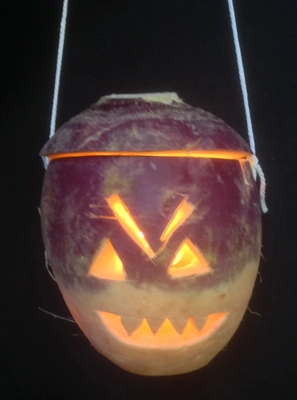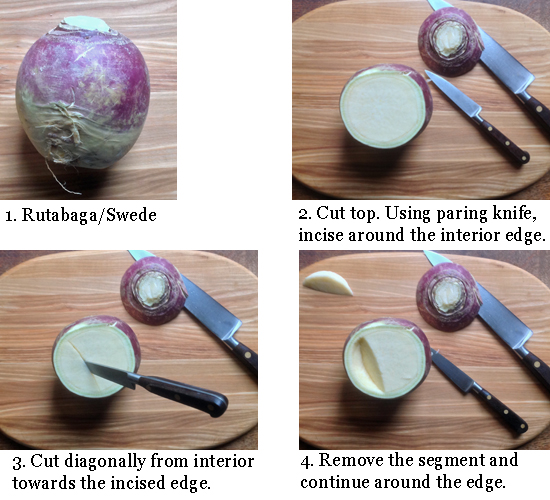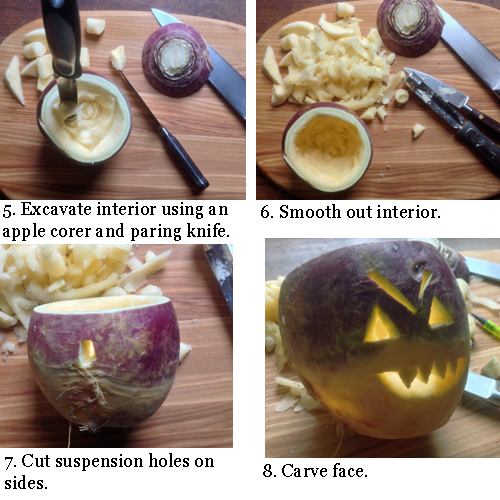Question: What do you get when you cross a turnip with a cabbage?
Answer: A Rutabaga (known as a Swede in England or a Neep in Scotland)
This root vegetable with the odd parentage grows in cold northern lands and is thought to have originated in Scandinavia, Central Europe or Russia. No one knows for sure. However, we do know that the rutabaga was first described by a Swedish botanist in 1620. Not long after, it was documented in England and Scotland, but it wasn’t until the 18th century that it became more widely distributed. The rutabaga was introduced to the Americas in the early 19th century, possibly from Scandinavian immigrants.
As I mentioned in a previous post, Pumpkin Patch, a hollowed and carved turnip (by that, I mean rutabaga or swede) is generally considered to be the original jack o’lantern. Although, some sources indicate that a mangelwurzel was used. Don’t you just love that name? A mangelwurzel is a large yellowish root (similar in appearance to the rutabaga) grown as animal food and is sometimes called fodder beet. Traditionally, these vegetables were illuminated with a burning coal inserted in the hollow and were carried as lanterns by “guisers” in the British Isles as early as the 16th century. Guisers, who often played pranks, were youth who went house-to-house reciting verse in exchange for food. Sound familiar? We now call it trick-or-treat.
Halloween is thought to have its roots in the pagan harvest festival of Samhain, celebrated around the 31st of October when the veil that separated the world of the living and the world of the dead was thin, a time when spirits walked abroad. Disguises were worn to protect the wearer from recognition by those spirits and food offerings were placed outside to placate the dead. Bonfires, symbolizing regeneration, warded off evil spirits and embers from the fires were placed in hollowed turnips to safety transport the burning cinders to home hearths. The embers would start hearth fires that would sustain the home through the long, dark winter months.
Now, the mildly astringent rutabaga (swede or neep) is often a neglected vegetable in the modern kitchen. I’ve found an old recipe from Finnish immigrants to Wisconsin for a rutabaga savory pudding. It really should be called a rutabaga mousse because of its light, mousse-like texture. This is how to use those pieces of rutabaga excavated from your jack o’lantern. Or cook it, mash it and mix with mashed potatoes to make an Orkney speciality called Clapshot.
Finnish Rutabaga Pudding
This is similar to more common recipes for sweet potatoes, yams or winter squashes. The Finns traditionally consume it with the Christmas ham, but I have found it is equally delicious with turkey. The original recipe uses molasses instead of brown sugar.
- 3 cups Swede (= American Rutabaga), approximately 1-1/2 lbs (680g).
- 1/2 cup cubed white bread, crust removed (approximately 25 to 30g)
- 1/4 cup cream (60g)
- 1/2 cup milk (125g)
- 2 teaspoons salt
- 1/2 teaspoon black pepper
- 1/4 teaspoon Ground nutmeg
- 2 teaspoons brown sugar
- 2 eggs
- 2 oz. Butter (60g)
Peel and cut the swede into 1 inch chunks, cover with water, bring to a boil and reduce heat to medium and cover. Cook them until they are soft, approximately 30-40 minutes. If you are using the excavated pieces from jack o’lantern making, the cooking time will probably be less – check periodically for softness.
While the swede is cooking, preheat oven to 375 degrees F. and generously butter a 8 inch diameter casserole and set aside.
Meanwhile, using a small bowl, soak the bread in the milk. Drain the swede when done, return to pan and mash until they are smooth. I like my mashed (“bashed”) swede very smooth, so I have been known to purèe them in the food processor for a minute or two before returning it to the pot. Add the cream, salt, pepper, nutmeg and brown sugar. Mix well.
Beat the soaked bread and milk with a fork until it is a smooth paste and add to the mixture. Separate the eggs, beating the yolks in with the vegetable mixture and putting the whites into a separate bowl. Whisk the egg whites until soft peaks form. Fold this into the beaten vegetable mixture. Spoon this into the prepared casserole and dot the top with butter. Bake for about one hour until nut-brown on top.
How to Cave an Original Jack o’Lantern
My Posts
Related articles
- The story of Jack O’Lantern (madaboutyoulady.wordpress.com)
- Things to do with Rutabaga (www.theoldfoodie.com)
- Scottish food: Clapshot (Potato & Swede Mash)(londoneats.wordpress.com)





I really enjoyed this blog! Thank you!
LikeLike
🙂
LikeLike
Yum I love rutabaga roasted, I have never thought about them in a pudding- one to try!
LikeLike
I’ve never had it roasted. One for me to try!
LikeLike
Love the little history lesson along with the recipe! Thanks
LikeLike
Thanks!
LikeLike
I have always been intrigued by the idea of carving rutabaga but didn’t see how it would be possible. Thanks for the demonstration! Glyn
LikeLike
This was my first go at it and the apple corer worked really well – just make sure you have “wriggle room” to crack the core before lifting out. I had fun doing it. One of my Yorkshire neighbors remembers his Dad laboriously scoreing the flesh and scooping it out with a spoon.
LikeLike
Oh, I LOVE those carvings! Wish I had been up to date with my reading of blogs before Halloween. Now I’ve got to wait ’till next year! And that pudding looks oh, so delicious!
LikeLike
I really had fun carving the rutabaga. The one thing to remember is to cut away some of the periphery first so that your apple corer has room to move and “cracking” the core to remove. To make the savory pudding, you will need more rutabaga…unless you carve an enormous monster of a rutabaga!
LikeLike
[…] harvest season and and is widely believed to be incorporated in our Halloween customs (see my post The Original Jack o’Lantern). Whether Scandinavian or Celtic, it seems that Parkin and Thar’s Cake represent older pagan […]
LikeLike
I have never heard of a rutabaga but this is a turnip – so called all over Ireland and what we make our Hallowe’en lanterns from.
LikeLike
Rutabaga is simply the name given by people in North America to the same vegetable. I believe the word rutabaga has Scandinavian origins and that name probably came with immigrants from that area to the new world. In Scotland they refer to it as a turnip (usually) or sometimes a swede, but it is the same thing. Yes, you are right, it is the traditional thing that was carved for All Hallows Eve. Pumpkins are a North American intrusion!
LikeLike
[…] time last year The Original Jack o’Lantern Kitchen Lore: Halloween tradition of a carved […]
LikeLike
I always look forward to reading MY Kitchen Witch. It is a charming
mix of cooking tradition, anthropology and archaeology.
Thank-you!
LikeLike
Thank you – what a nice compliment. I enjoy all of these things, so it comes naturally.
LikeLike
What an inspired post!
LikeLiked by 1 person